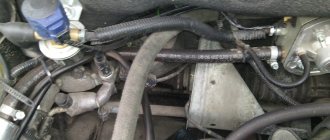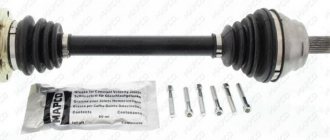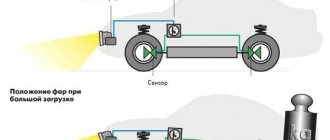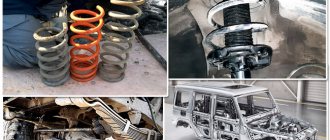Air suspension diagram
Air suspension is used in two cases: to increase comfort and when there is a large difference between the curb and maximum vehicle weights. In trucks, it is built into a complex pneumatic circuit along with brakes ( ZR, 2012, No. 7 ). For passenger cars, the system includes body level sensors, a tank receiver for storing prepared air, a compressor with a dryer and a temperature sensor, an electronic control unit, solenoid valve blocks, as well as the pneumatic elastic elements themselves. The air movement pattern is simple. The compressor sucks it in from the atmosphere and, driving it through a dryer, fills a receiver with a capacity of 5–10 liters. Here it is stored under pressure, reaching 20–23 bar during operation. To get rid of moisture, absorbent granules are used.
Principle of operation
The main task of the air suspension is to maintain a given level of body height above the road and effectively absorb all irregularities. The system can be controlled either manually or automatically. And here every year the manufacturer has more and more opportunities. The data received from the sensors is transmitted to the control system, and it already issues commands to the actuators: pump up and increase the pressure, or relieve pressure from the front or rear circuit (or both at once) and press the car body to the asphalt at the minimum permissible distance at high speed. Each air suspension has its own settings and purpose, which depend, first of all, on the type of car.
Variety of species
Types of car air suspension
If your car did not have a factory air suspension, but you have a desire to install the air suspension yourself, then it will be important to study the variety of air suspensions. So, the main types of air suspension:
- single-circuit. Designed for one circuit (axle), the pressure in both axle pads will be the same;
- double-circuit on two axes. Similar to single-circuit ones, they are simply installed on both axles of the car, allowing you to adjust the front and rear of the car;
- double-circuit on one axis. Allows you to adjust all four wheels separately;
- four-circuit. The most optimal, expensive and functional type of air suspension.
It is worth understanding that the cost of an air suspension kit will depend not only on its type, but also on the class of vehicle on which it will be installed.
Flaws
There are not many disadvantages, but they are significant. The first drawback is low maintainability. This is especially true for the front suspension. If the pneumatic struts fail, they are replaced entirely. Cylinders cannot be restored in case of leaks.
So, we found out what air suspension is and what its main features are.
Air suspension is a type of car suspension that has the ability to adjust the ride height. It can be adjusted automatically or forcibly, but without the use of human physical force.
Where did air suspension come from?
It turns out that more than 70 years ago pneumatic elements in suspension parts were used on trucks and semi-trailers. Recently, the use of air suspension on passenger cars has become quite popular practice. And on the streets you can often find 20-30 year old examples of mostly French cars, for example Citroen, with hydropneumatic suspension. But it’s not uncommon these days not only for the factory installation of this type of suspension. In the countries of the former Great Union, you can see domestic cars with modified suspension; craftsmen also manage to install pneumatic elements on them.
What is the difference between air suspension and conventional suspension?
In addition to air springs, the design of the car uses a supercharger compressor, a receiver (a reservoir for compressed air) and air distribution systems. Air is supplied and discharged into the cushions using valves. All processes are controlled by the control unit. The characteristics of the compressor and its power, as well as the diameter of the valves and other characteristics are selected individually for each model.
The main and fundamental difference between an “air-pumped” suspension and a spring suspension is the absence of metal springs in its design. Their role is played by air bags. And the owner of a car with air suspension has the opportunity to regulate the driving performance of the car by changing the pressure in those very airbags, essentially the stiffness and height.
What is the advantage of air suspension?
Tastes could not be discussed. And since not all automakers use air springs in the design of their models, we will highlight its most important qualities.
- Changeable settings. Essentially, this is the ability to adjust the ground clearance over a fairly wide range. Thereby changing the height of the car and the stiffness of the suspension. After all, simply replacing springs with harder/softer or lower/higher ones may not give the expected result in terms of driving characteristics. In addition, changing the height and stiffness of the springs inevitably tilts the car in a certain direction of use, making it narrowly targeted.
By the way, short and stiff springs perform well on good asphalt, improving handling. But the suspension becomes too rough and in some cases driving on broken roads turns into torture. And long and soft springs are good on off-road and bad asphalt, but this negatively makes the car a kind of lump with loose steering. Everything in moderation, of course, but any replacement pulls the blanket in its favor to one degree or another.
With air suspension there is simply no such problem. In cars where air bags are installed instead of springs, the driver has the right to choose any available height and stiffness of the suspension. Which does not entail discomfort and does not force you to seek compromises. With it, you can select the required level of rigidity on any surface.
- Excellent handling. One of the characteristics of air suspension is its progressive compression. In other words, the more the air spring is compressed, the more pressure is created in it, increasing rigidity. That is, it is quite difficult to “break through” the air suspension to the bump stop. And the ability to regulate pressure gives the driver enormous opportunities to customize the driving characteristics of the car. Cars with air suspension are characterized as more stable on the road and capable of less roll compared to cars with spring suspension.
- Extensive customization options. Each driver has his own preferences and views on car handling. In addition, the car does not always have one driver. Passengers can also sit in the car, thereby loading the suspension and changing its behavior on the road. All these nuances and differences can be easily leveled out by the air suspension. Therefore, the driver can easily adjust the suspension to suit himself, his driving style, load and degree of workload.
- Individuality and practicality. Those who like to attract attention can lower or raise their car to its extreme position. For many, this is the decisive factor in converting their car.
- It’s not for nothing that air suspension has been used on trucks for a long time. The capabilities it gives the car in terms of carrying capacity cannot be overestimated. And this practically does not change the driving characteristics of the car. This advantage is very important for owners of pickup trucks and minivans, where the level of congestion often varies greatly.
- The air suspension performs well when used in severe frosts due to the use of elastic rubber elements.
Advantages
For the sake of this characteristic, many people overpay that much money for installing air suspension. But comfort is not the only advantage of this system. If we talk about commercial vehicles, installing air suspension allows you to increase the load capacity without harming the chassis. And the load itself, thanks to the pillows, will remain intact, since the springs dampen vibrations more rigidly.
The next plus is the high stability of the car on the road. Many. It allows you to eliminate rolls when cornering. This can also be done on a spring suspension by clamping the travel of the shock absorbers. However, driving comfort will remain in question.
Another plus is the ability to adjust the clearance. Usually this is a range of 10-15 centimeters. The driver will not have to cut or extend springs to achieve specific ride characteristics. All this changes in a matter of seconds, right from the salon.
What is "pneumatics"
Of course, modern high-quality shock absorbers make driving a car with a classic suspension quite comfortable, but that’s probably all that can be said about the “classic”. No matter how elastic the springs and springs of such a suspension may be, the entire structure retains a high degree of rigidity. This means that the ground clearance (the distance between the bottom and the road surface) of a car equipped with a classic suspension remains unchanged.
This element was developed and put into operation to provide the driver with a greater degree of convenience and a high level of safety while driving.
Air suspension has become widespread on car trailers and truck-type equipment.
However, business-class passenger cars are also often equipped with “pneumatics” - this gives the model a special status and attracts the attention of those who value safety and convenience, while having the opportunity to purchase such a car.
Application of air suspension
The simplest pneumatic systems (which, by the way, does not mean cheap) can only be installed on the rear axle. Often such solutions can be found on station wagons and large crossovers. The system assumes periodic increased load on the rear axle, so it adjusts the ground clearance and suspension stiffness depending on the load. Basically, such schemes work in tandem with the Multilink multi-link, but can also be used with MacPherson struts. Moreover, such an air suspension allows you to “lower” the car as much as possible, which greatly simplifies loading and unloading.
Mercedes air suspension control buttons
However, most often pneumatics are installed on all four wheels. This makes it possible to more flexibly control clearance. This design is used not only on expensive crossovers, but also on sports cars, where every millimeter of ground clearance will affect aerodynamics and, as a result, speed and handling.
In recent years, the design of air suspension has become increasingly reliable, which makes it possible to install it not only on expensive cars in the premium segment. The use of air suspension allows you to make driving more dynamic, increase the smoothness of the ride and the level of comfort. This is achieved due to the ability to change the position of the body and the degree of damping of the shock absorbers.











